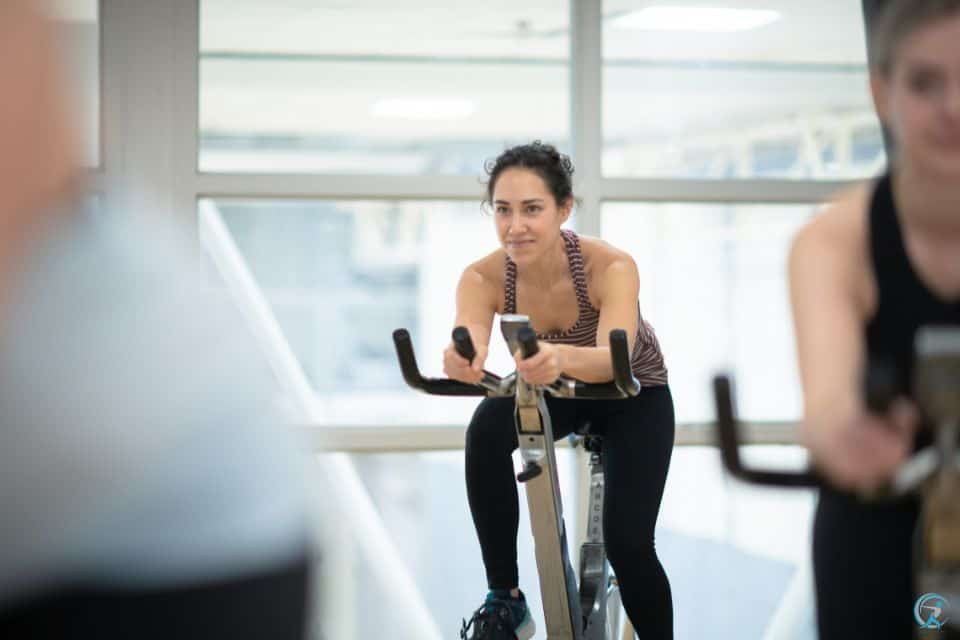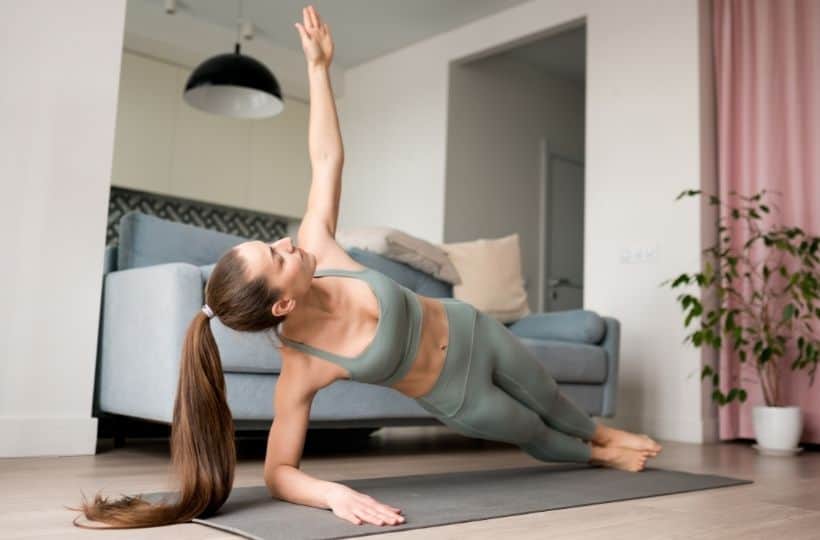Indoor and outdoor cycling have pros and cons. Burning 700 calories in a single session? Cycling is powerful, no matter if you prefer the thrill of the outdoors or the intensity of an indoor studio.
But with two distinct cycling worlds, how do you decide which one fits your fitness goals and lifestyle? Learn the main differences between indoor and outdoor cycling and find the best way to improve your fitness journey.
Key takeaways:
- Indoor cycling offers controlled environment, targeted workouts, and convenience. Great for cardio, muscle building, and injury rehab.
- Outdoor cycling provides mental wellbeing, vitamin D, and varied terrain. Ideal for exploring, building endurance, and strengthening lower body muscles.
Indoor vs. Outdoor Cycling: A Quick Comparison
| Feature | Indoor Cycling | Outdoor Cycling |
|---|---|---|
| Environment | Controlled, weatherproof | Uncontrolled, weather-dependent |
| Terrain | Flat, stationary | Varied, with hills and inclines |
| Resistance | Adjustable | Natural, wind resistance |
| Guidance | May have instructor-led classes | Self-guided or GPS-guided |
| Socialization | Group classes available | Can be done solo or with others |
| Mental Wellbeing | May be less stimulating | Offers connection with nature |
| Vitamin D Exposure | Limited | Abundant sunlight exposure |
| Muscle Activation | Primarily leg muscles | More core and lower body engagement |
| Convenience | Accessible year-round, any time | Requires planning for weather conditions |
| Safety | Lower risk of accidents | Higher risk of accidents (traffic, terrain) |
| Cost | Gym membership or stationary bike cost | Bike cost, maintenance, potential gear costs |
Exercise Bikes

Exercise bikes provide many health benefits, with customizable training settings and accessories to make your workout more comfortable. These machines are widespread and found in most gyms or exercise stores.
Benefits
Indoor cycling differs from outdoor cycling in several ways. With an indoor bike, you can tailor the workout to your liking by adjusting the bike’s features. This customization offers health benefits. Indoor cycling allows you to burn calories every day with less muscle strain than outdoor cycling. Many stationary bikes have settings that mimic going uphill or downhill. This feature adds more resistance to your workout.
Disadvantages
If an indoor bike breaks or the electric parts stop working, fixing it can take time and disrupt your workouts. Repairs can be expensive, and severe damage might require buying a new bike.
Using the bike helps you burn calories and lose weight. However, its predictable nature limits muscle stress and growth. Your body anticipates the workout, using adrenaline and nutrients to adapt. This predictability prevents your muscles from encountering new challenges that would force them to develop further.
Bicycle

A classic method of exercise, outdoor cycling is a reliable workout. Many people rode bikes throughout their lives, so there are many people to start a cycling group with. Biking with friends can boost morale and improve your cardio endurance.
Benefits
Bicycles are cheap and good for the environment. They help you travel. Biking on different terrains builds muscles. It makes you use more energy to keep balanced. Fresh air is healthy for your lungs. It also brings more oxygen to your body. Sunlight gives you vitamin D, which is good for your bones. Bicycling is a great reason to leave the house.
Disadvantages
Although freeing, riding out in the world is more dangerous. Accidents are a constant threat, and you must be more cautious while riding. Riding uphill can be challenging, especially on steep slopes, which can tire your muscles if you’re in the wrong gear.
Exercising indoors gives you a greater sense of control.

Indoor cycling has many advantages over outdoor. For example, you can choose the speed and resistance of your ride. You can also pick your music route and see how much time has passed by looking at the display on your bike.
Indoor cycling allows for more control during workouts as it is not affected by outdoor weather conditions (excluding indoor-outdoor hybrid bikes). It’s also easier to focus on what matters most during an indoor workout: getting fit!
You can use indoor cycling to target specific muscle groups.
If you want to focus on certain muscles and get fit, indoor cycling is a great option. It can be better than outdoor cycling for this because you don’t have the same resistance from wind outside. Indoor bikes have a flywheel and pedals.
These create resistance, like going up or down a hill. This resistance makes indoor cycling tougher than outdoor biking. It helps build strength in your legs, core, and glutes. However, this challenge might make beginners tired quickly. They might stop cycling sooner than they wanted because of the hard workout.
Indoor cycling requires less space and equipment.
You can use a stationary bike at home or join a gym with indoor cycling classes, so you don’t have to worry about the weather. You can also use an indoor bike at a gym or enter a cycling class where other people will do their workouts with you.
A trainer or instructor is always on hand when you exercise indoors.
When you work out inside, a personal trainer or instructor is there to help. They assist with your technique and encourage you to push harder. They also keep you motivated and help with injury recovery. An indoor cycling class can be as effective as outdoor cycling for your heart health. Plus, you have the extra advantage of someone watching out for issues like overstraining during the exercise.
You can simulate outdoor riding conditions with indoor cycling classes in a studio or gym.

When you ride outdoors, wind can help or hinder you. For instance, in cold, snowy weather, you need to wear extra layers before going for a ride. However, if it’s over 70 degrees Fahrenheit (21 Celsius), wearing less can prevent overheating during your workout.
Indoor cycling classes offer a way to experience various weather conditions safely. You don’t have to worry about rain or extreme heat. This convenience attracts many people, especially those living in places with very cold winters or very hot summers. Indoor cycling lets them enjoy the feel of outdoor rides all year long.
Focusing on technique over speed is essential to get the most out of your workout.

Cycling is a great exercise, but focusing on technique is better than speed for a good workout. Indoor and outdoor cycling have some differences:
Outdoor cycling has varied terrain, letting you pick routes that fit your fitness and goals. You could choose an uphill path with twists for leg and strength and endurance. Or, for speed, a flat road with few traffic lights or stop signs helps maintain fast speeds without stopping.
Not everyone has access to indoor cycling studios, which often cost extra. Outdoor cycling gives more freedom, with no strict rules on how often or how long you ride. However, weather can impact outdoor cycling plans.
Key Considerations When Choosing Between Indoor and Outdoor Cycling
| Factor | Indoor Cycling | Outdoor Cycling |
|---|---|---|
| Fitness Goals | Cardio, muscle building (controlled environment) | Endurance, overall fitness, mental wellbeing (varied terrain) |
| Lifestyle | Busy schedules, unpredictable weather | Enjoy spending time outdoors, adventurous spirit |
| Budget | Varies depending on gym membership or bike cost | Varies depending on bike type and desired gear |
| Safety Concerns | Lower risk, suitable for beginners | Higher risk, requires awareness and caution |
| Personal Preference | Structured workouts, controlled environment | Sense of freedom, connection with nature |
The Best Option

Despite the differences between indoor and outdoor cycling, both bikes are viable choices, and it falls upon the person’s preferences for which is better at the end of the day. Using either one of these bikes will benefit your health and lead to muscle growth.
Both bicycles and exercise bikes are great workouts and have advantages and disadvantages. Which is the better bike will depend on what the person favors.
Scientific Studies
According to a Journal of Sports Science and Medicine study, outdoor riding requires more heart rate, oxygen usage, and blood lactate concentration in skilled riders. Outdoor riding may be more difficult than indoor cycling for cardio. (https://www.ncbi.nlm.nih.gov/pmc/articles/PMC6467784)
Outdoor cycling boosts vitamin D exposure, which helps bones, immune systems, and other bodily functions. It increases vitamin D levels due to sunshine exposure, according to research. PLOS ONE found that outdoor bikers had substantially higher vitamin D levels than indoor cyclists. (https://journals.plos.org/plosone/article?id=10.1371/journal.pone.0166812)
Riding Improves Mood Well-being: Outdoor activity, including riding, has improved mood, self-esteem, and well-being. According to a Journal of Environmental Psychology study, outdoor cycling increases energy, reduces stress, and revitalizes more than indoor exercise. (https://www.sciencedirect.com/science/article/pii/S0272494412000715)
Outdoor riding offers environmental diversity and unique physical and mental obstacles. The Journal of Strength and Conditioning Research found that riding on natural ground activated lower body muscles more than stationary cycling. Outdoor riding may be more varied and difficult than indoor cycling. (https://journals.lww.com/nsca-jscr/Fulltext/2014/11000/The Effects of Terrain on Muscle Activity and.27.aspx)
Indoor cycling helps riders manage force output and cadence. The International Journal of Sports Physiology and Performance found that indoor cycling improved elite cyclists’ efficiency. The study also suggested that riders cycle outdoors to prepare for real-world riding. (https://journals.humankinetics.com/view/journals/ijspp/13/2/article-p166.xml)
Conclusion
Cycling has many benefits, but it’s important to remember that focusing on technique over speed is the best way to get those benefits. When riding outside and feeling like you’re pushing yourself too hard, try slowing down a bit. Your body will thank you later!
References
Cardio:
- Outdoor cycling might have the edge: A 2004 study published in the Journal of Sports Science & Medicine (https://pubmed.ncbi.nlm.nih.gov/2868515/) found that outdoor riding required more heart rate exertion and oxygen usage in skilled cyclists, suggesting a potentially greater cardio challenge compared to indoor cycling.
Vitamin D:
- Sunshine is your friend: Outdoor cycling allows you to soak up the sun’s rays, naturally boosting your vitamin D levels. A 2016 study in PLOS ONE (https://pubmed.ncbi.nlm.nih.gov/25277808/) found that outdoor cyclists had significantly higher vitamin D levels compared to their indoor counterparts.
Mental Wellbeing:
- Nature’s mood booster: Studies suggest that outdoor exercise, including cycling, can significantly improve mood, self-esteem, and overall well-being. A 2011 review in Environmental Science & Technology (https://pubs.acs.org/doi/10.1021/es102947t) highlighted the positive impact of outdoor activity on mental health.
Muscle Activation:
- Terrain matters: Uneven surfaces and inclines of outdoor cycling engage various muscle groups more than stationary cycling. A 2014 study in the Journal of Strength and Conditioning Research (https://journals.lww.com/nsca-jscr/fulltext/2024/03000/effects_of_a_strength_and_conditioning_offseason.27.aspx) observed increased lower body muscle activity during off-road cycling compared to stationary cycling.
However, the American Council on Exercise (ACE) (https://www.acefitness.org/resources/everyone/exercise-library/), a reputable source for fitness information, emphasizes that both indoor and outdoor cycling offer numerous health benefits, including:
- Cardiovascular improvement
- Weight management
- Muscle strengthening
- Improved balance and coordination
- Reduced stress and anxiety
Ultimately, the choice between indoor and outdoor cycling depends on your individual preferences and fitness goals. Consider the factors discussed above, and don’t hesitate to consult with a healthcare professional for personalized guidance.
As a veteran fitness technology innovator and the founder of GearUpToFit.com, Alex Papaioannou stands at the intersection of health science and artificial intelligence. With over a decade of specialized experience in digital wellness solutions, he’s transforming how people approach their fitness journey through data-driven methodologies.
